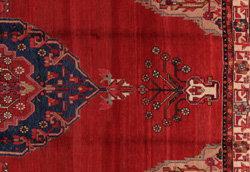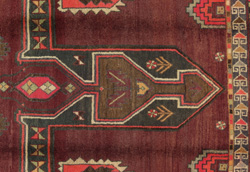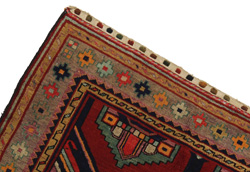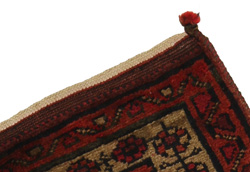Main Category
Origin
|
Size/Shape
|
Lori - Gabbeh Persian Rug 10'3"x6'4"
The colours of each carpet look different depending on the side from which you look at it. You can see the carpet from different perspectives in the images below:
(click on the images below for greater detail)
- Discount Price: £ 502 -30%
- Retail Price: £718
- Rug Code: unq3872-297
- Size: 10'3"x6'4"
- Thickness: Medium (5-10 mm)
- Age: 0-20 (New)
- Pile - Warp: Wool on Cotton
- Knot Density: approximately 90.000 knots per m²
- Rug colors:
Lori Rugs : Rugs woven by the Lurs, a nomadic tribe in the mountainous Kurdish region of Southwest Iran, bordering Iraq. The Lori rugs usually have geometric shapes, often with rhombi and strictly linear scenes of the herbal and animal world. Because the areas where the Lurs live are inaccessible and isolated, they still weave with the old traditional ways, without influences from the Europeans. The centre of Luristan is Choremabad, which gave its name to the rugs woven there. Furthermore rugs have been named after the salt lake Neris.
Gabbeh Rugs : Gabbeh in Farsi means natural, primitive. Rugs and rugs with this name are woven by the nomads Qashqai who roam about, or in villages in Southwestern Iran where they live. The yarns are processed and twisted by hand, painted with herbal colours and woven with a wool warp up to 2 cm thick. These rugs are simple, with few designs, or monochrome. The simple, linear designs with animals and human figures give them a contemporary look. Various names are given to Gabbeh rugs such asBasic, Amalehbaft, Kashkooli, Luribaft and Sumak. Gabbeh Kashkooli is a rug with high knot density and thinner than ordinary Persian Gabbeh rugs. The Persian Gabbeh is very durable and its quality is very good.
Nomadic rugs: Rugs woven by nomads. Nomads move continuously and do not stay permanently in one geographic region. They manufacture (weave) handmade rugs on collapsible looms. Due to that fact there may be slight variations in weaving and their rugs are sometimes uneven in shape. Also the weaving is made from memory and it depends on each artisans momentary inspiration. As a result, the designs in some rugs are not even on the entire surface.
All CarpetU2 carpets are subject to cleaning with high quality antibacterial and moth protection products according to Persian law.
Horizontal or vertical shading in the rug pile: The shading is due to folding the rug during transportation. When the rug is laid and stepped-on they will vanish. Examples
Flat woven at one or both ends of the rug's width: In some rugs the nomads weave at fringes on a narrow Kilim one or both sides of the width, or they weave them artistically into small braids. It is a technique various weavers use for a greater durability or simply to demonstrate their skill. Examples
Abrash: Due to the different amount of grease in the wool and the added salt during the process of dyeing, the wool has got a varying colour absorbance. This is not very visible before weaving. During the weaving though, lines of the same colour are formed in the rug. This is called Abrash (which in Farsi means little cloud) and it shows that the wool was not manufactured using chemical means and marks the naturalness and authenticity of the rugs. Examples
You have to choose at least two (2) rugs!
You can select up to six (6) rugs to compare!

 Click here for larger image
Click here for larger image


























